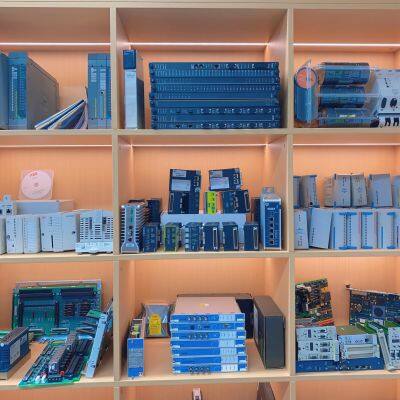Product Description
I. Product Overview
Allen-Bradley 1794-OB16 is a FLEX Digital DC Output Module. In today's complex and evolving industrial automation system, with its excellent performance and high reliability, it has become one of the key devices for achieving precise control and ensuring stable operation of the system.
In terms of hardware design, the module adopts a compact and optimized layout. This exquisite design enables it to easily fit into the limited space inside various control cabinets, creating extremely favorable conditions for convenient and efficient combined installation with other equipment. Its shell is made of sturdy and durable materials, featuring excellent anti-vibration and anti-impact performance, which can effectively resist the mechanical stress common in industrial sites. At the same time, it also has good dust-proof characteristics, allowing it to operate stably in dusty environments, effectively protecting internal precision circuit components, thus greatly extending its service life and ensuring that the operation reliability is always maintained at a high level.
In the actual operation of industrial sites, the 1794-OB16 module is mainly responsible for converting the digital signals from the control system into DC output signals that can drive external equipment. It can accurately receive instructions from devices such as Programmable Logic Controllers (PLCs), and quickly and accurately output stable DC current to various executive components, such as small relays, solenoid valves, indicator lights, etc., to achieve refined and precise control of industrial equipment. It plays a key role in connecting the control center and the executive mechanism in the entire industrial automation system, ensuring the smooth operation of the system.

II. Performance Parameters
(1) Electrical Performance
Operating Voltage
The module supports a wide range of DC voltage inputs, with a minimum operating voltage of 10V DC, a rated operating voltage of 24V DC, and a maximum operating voltage of up to 31.2V DC. This wide voltage adaptation capability enables it to well match various power supply systems in industrial sites, greatly improving the convenience of system integration. Whether in conventional industrial scenarios using standard 24V DC power supplies, or in complex environments with voltage fluctuations or special power configurations, the 1794-OB16 can stably obtain working power, laying a solid foundation for the normal and efficient operation of various functions.
Output Characteristics
Number of output channels: The module is equipped with 16 output channels, each of which can be independently controlled, capable of driving multiple external devices at the same time, meeting the basic control needs of most industrial automation projects. In some complex production lines that need to control multiple executive components at the same time, such as the parts assembly link in the automobile manufacturing production line, 16 output channels can respectively control different fixtures, valves and other equipment to achieve efficient collaborative work.
Output current capability: Each channel has excellent output current capability. The minimum output current is 1.0mA, which can meet the normal working needs of some devices with low driving current requirements, such as small indicator lights; the maximum output current can reach 500mA, which can directly drive small relays, solenoid valves and other executive components. The rated output current of the entire module is 8.0A (that is, 16 output channels, each calculated at 0.5A), which enables it to stably output sufficient current when facing multiple load devices, ensuring the reliable operation of the devices. In practical applications, if it is necessary to drive higher-power devices, the current can be amplified by means of an external relay.
Output voltage drop: When the output current is in working state, the output voltage drop of the module is strictly controlled within a very small range, with a maximum voltage drop of only 0.5V DC. This feature ensures that even in the case of long-distance transmission or connecting multiple loads, the voltage output to external devices can still be maintained within the range required for the normal operation of the devices, effectively avoiding the problem that the devices cannot work normally due to excessive voltage drop.
Output inrush current: The module has the ability to handle inrush current, which can withstand up to 2A inrush current for 50ms, and can repeatedly withstand such inrush impacts every 2 seconds. This feature enables the module to effectively protect itself and connected devices from damage caused by excessive inrush current when the device starts or is subject to external interference, ensuring the stability and reliability of the system.
(2) Environmental Adaptability
Operating Temperature
The 1794-OB16 has a wide operating temperature range and can operate stably in the temperature range of 0℃ to 55℃. This feature enables it to perfectly adapt to the common temperature changes in industrial production workshops. Whether in hot summer or cold winter, it can always maintain stable performance, ensuring that the control process is not affected by temperature fluctuations at all. In high-temperature industrial environments such as steel smelting, and low-temperature environments such as refrigerated logistics, the module can perform tasks reliably, providing continuous and stable control support for industrial production.
Storage Temperature
Even in non-working state, the module can be stored in a wide temperature range. Its storage temperature range is -40℃ to 85℃, which means that during equipment transportation, long-term storage, etc., there is no need to worry about damage to the module due to unsuitable ambient temperature, which greatly improves the applicability and maintainability of the product.
Relative Humidity
The module can still work normally in an environment with a relative humidity of 5% - 95% (non-condensing). This makes it particularly suitable for humid industrial places such as food processing workshops and water treatment plants, effectively avoiding circuit short circuits, component corrosion and other faults caused by humidity problems, and strongly ensuring the long-term reliable operation of the module. In a humid environment, the circuit design and protective measures inside the module can ensure that moisture will not have a negative impact on its normal operation, maintaining stable output performance.
Anti-vibration and Anti-impact
The module is fully designed to consider the vibration and impact in industrial sites, and has excellent anti-vibration and anti-impact performance. It can withstand 5g (gravitational acceleration) vibration in the frequency range of 10Hz to 500Hz, and 30g operating impact. This enables it to maintain a stable working state when installed near equipment with large vibration, such as large motors, compressors, etc., or when encountering bumps during transportation. It will not cause loosening or damage of internal components due to vibration or impact, ensuring the accuracy of signal transmission and the reliable execution of control commands.
Anti-electromagnetic Interference
It strictly complies with industrial-grade electromagnetic compatibility standards and has strong anti-electromagnetic interference ability. In industrial sites, motors, frequency converters, high-voltage equipment, etc. will generate strong electromagnetic interference, and the 1794-OB16 can effectively resist these interferences, ensure the accuracy of signal transmission and the reliable execution of control commands, avoid misoperations caused by interference, and maintain the stable operation of the system. In large factories with complex electromagnetic environments, there are a large number of equipment generating electromagnetic interference around, but the module can stably output control signals by virtue of its excellent anti-interference performance, ensuring the stable operation of the entire automation system.
(3) Response Speed
The signal processing and response speed of the module are excellent, and the delay time of the output signal is extremely short. The response time from receiving the output on or off command to the actual output on or off is 0.5ms from off to on and 1.0ms from on to off, respectively. Such a fast response speed enables it to quickly respond to the instructions of the control system, control the actions of external devices in a timely and accurate manner, and fully meet the strict real-time requirements of industrial automation systems. In some industrial scenarios with high requirements for response speed, such as high-speed automated production lines and real-time monitored chemical reaction processes, the module can respond quickly, providing strong support for the efficient and stable operation of the system. For example, in the high-speed placement machine for electronic chip manufacturing, the 1794-OB16 can quickly control the lifting and movement of the suction nozzle, realizing precise and rapid placement of chips, which greatly improves production efficiency and product quality.

III. Functional Characteristics
(1) Output Status Indication
Indicator Light Design
The module is equipped with 16 yellow LED status indicators, each corresponding to an output channel. Through these indicators, operators can intuitively and clearly understand the working status of each output channel. When a channel is in the output state, the corresponding indicator light will be on; when the channel is closed or a fault occurs, the indicator light will be off or show an abnormal state. This intuitive status indication method greatly facilitates operators to monitor the operation of equipment on site in real time, enabling them to quickly find problems and take corresponding measures, improving the efficiency of equipment maintenance and fault troubleshooting. In a complex automation control system, operators can quickly determine which output channel has a problem by observing these indicators, so as to carry out maintenance or adjustment in time, reducing the production downtime caused by equipment failure.
Fault Diagnosis Assistance
These indicators can not only show the normal working status of the output channels, but also provide important clues for fault diagnosis when the module fails. For example, if an indicator light flashes continuously or shows an abnormal color, it may indicate that the circuit corresponding to the channel has problems such as short circuit, open circuit or overload. Maintenance personnel can quickly locate the fault point according to the abnormal state of the indicator light, carry out targeted inspection and repair, effectively shorten the system downtime and reduce production losses.
(2) Flexible Connection Methods
Multiple Compatible Terminal Bases
The 1794-OB16 is compatible with a variety of terminal bases, including 1794-TB2, 1794-TB3, 1794-TB3S, 1794-TB3K, 1794-TB3SK, etc. This flexible compatibility allows users to choose the most suitable terminal base according to the actual application scenario and wiring needs, so as to achieve convenient and reliable wiring. Different terminal bases may differ in wiring methods, protection levels, spatial layout, etc., and users can choose flexibly according to specific project requirements. In some outdoor industrial applications with high protection level requirements, terminal bases with waterproof and dustproof functions can be selected to ensure reliable connection of the module in harsh environments.
Easy Wiring and Installation
No matter which terminal base is chosen, its design fully considers the convenience of wiring. The connection between the module and the terminal base is simple and intuitive, easy to operate, which greatly reduces the errors and time costs in the wiring process. At the same time, the module adopts the standard DIN rail installation method, which can be easily installed on the DIN rail in the control cabinet. The installation process is fast and convenient, and the installation position is stable, which is convenient for maintenance and management. When installing equipment in the control cabinet, technicians only need to clamp the module into the DIN rail and wire according to the marks to complete the installation, which greatly improves the installation efficiency.
(3) Electronic Protection Functions
Overcurrent Protection
The module has a complete overcurrent protection function. When the current of an output channel exceeds its rated value, the protection circuit will act quickly and automatically cut off the output of the channel to prevent equipment damage or safety accidents caused by overcurrent. Once the overcurrent situation is eliminated, the protection circuit can automatically restore the normal output of the channel without manual intervention. In practical applications, if a short-circuit fault occurs in an external device, causing the current through the 1794-OB16 output channel to increase sharply, the overcurrent protection function will start immediately to cut off the current of the channel, protecting the safety of the module and the device.
Short Circuit Protection
In addition to overcurrent protection, the module also has a short-circuit protection function. When a short circuit occurs in the output channel, the protection circuit can respond quickly and cut off the power supply of the short-circuit channel, avoiding permanent damage to the internal circuit of the module and external devices caused by the large current generated by the short circuit. After the short-circuit fault is eliminated, the module can automatically resume normal operation. In some complex electrical systems, short circuits may occur due to line aging, insulation damage, etc. The short-circuit protection function of 1794-OB16 can deal with this situation in time to ensure the safe and stable operation of the system.
Reverse Voltage Protection
To prevent damage to the module due to reverse polarity when external devices are connected, the 1794-OB16 is also designed with a reverse voltage protection function. When a reverse voltage is detected at the output end, the protection circuit will act immediately to block the reverse current, protecting the module from the impact of reverse voltage. This protection function improves the reliability and stability of the module in practical applications, and can effectively protect the module from damage even if there is a wiring error during installation.
Allen-Bradley 1794-TB3 I/O Terminal Base Unit
Allen-Bradley 1785-BCM Backup Communications Module
Allen-Bradley 1785-CHBM ControlNet PLC-5 Hot Back Cartridge Module
Allen-Bradley 1785-L20B Enhanced PLC-5/20 Programmable Controller
Allen-Bradley 1785-L40C ControlNet Processor Module
Allen-Bradley 1785-L40C15/F Programmable Logic Controller


Allen-Bradley 1785-LT Series PLC-5 Programmable Controllers
Allen-Bradley 1785-LT2 Series PLC-5 Programmable Controllers
Allen-Bradley 1785-M100 Memory Cartridge
Allen-Bradley 1785-ME64 Electrically Erasable Programmable Read-Only Memory (EEPROM) Module
Eaton 1785T-PMPP-1700 Operator Interface Module
Allen-Bradley 1771-ACN Communication Module
Allen-Bradley 1771-ASB Remote I/O Adapter Module
Allen-Bradley 1771-CFM Configurable Flowmeter Module
Allen-Bradley 1771-DB BASIC Module
Allen-Bradley 1771-HS1 Controller Module
Allen-Bradley 1771-IBD 16 Point Digital Input Module
Allen-Bradley 1771-IBN Digital Input Module
Allen-Bradley 1771-ID16 Isolated Input Module
Allen-Bradley 1771-IFE Analog Input Module
Allen-Bradley 1771-IFMS Intrinsically Safe Fast MillivoltInput Module
Allen-Bradley 1771-IM AC/DC Input Module
Allen-Bradley 1771-IR RTD Input Module
Allen-Bradley 1771-IXE Thermocouple/Millivolt Input Module
Allen-Bradley 1771-IXHR High Resolution Thermocouple/Millivolt Input Module
Allen-Bradley 1771-NIV Analog I/O Module
Allen-Bradley 1771-OA AC Output Module
High Performance B&R 8MSA4M.E3-86 Precision Servo Motor
Efficient B&R 8MSA3M.R0-42 Advanced Servo Motor
Reliable B&R 8LSA35.E2060D000-0 High-Speed Servo Motor
 yezi
Hi there! Welcome to my shop. Let me know if you have any questions.
yezi
Hi there! Welcome to my shop. Let me know if you have any questions.




